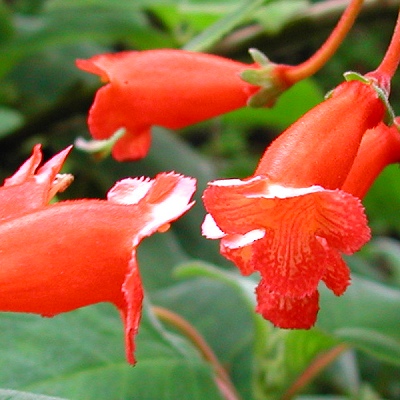Germinating the seeds
Germination is similar to Begonias (not tropical terrarium Begonias), so if you have germinated them before, you may use the same technique. Getting started - The seeds are very small, so work in a well-lit area. You may start the seeds in small pots 2 inches (5 cm) tall and wide, with drainage holes. Fill each container with a well-draining
mix. A typical mix is 2 parts potting soil to 1 part
perlite Sprinkle several seeds on top. An easy way to pick them up is by breathing on your fingertip to lightly moisten it, then dab the seeds to pick a few up. After sprinkling them over the soil, cover with a thin layer of long-fibered sphagnum moss (not ground peat moss). This helps retain moisture around the seeds while allowing light to reach them, which aids germination. This photo shows how much moss to use. If you don't have sphagnum moss, sprinkle a very thin layer of your potting mix around the seeds. Add water until everything is evenly moist (but not fully saturated). For the next few weeks, ensure that the soil surface stays moist at all times. To maintain moisture, you may enclose the pots in a clear plastic container or bag. Keep it open slightly to allow a little fresh air in. You may need to drip a few drops over the surface to keep it moist. Keep the pots at about 65-77 degrees (18-25°C). Avoid letting them get above 80°F (27°C) for prolonged periods. I recommend placing a minimum/maximum thermometer near the pots. Place the containers in a bright spot out of direct sun. An LED or fluorescent lamp kept 4 inches (10 cm) away provides the right amount of light (See: "Growing indoors with LED lights"). The seeds usually begin sprouting within about 3 to 5 weeks, and can continue for another month. Once they sprout, increase the amount of fresh air by opening the bag or container a little more. Continue keeping the soil surface moist the first month, because since the seedlings have a small root system. Once they are a month old, you do not need to keep the surface moist, but do keep the rest of the soil moist (but not soggy). Continue giving bright light, but not direct sun. Fertilizing -- The first 3 months, feed weekly with a small amount of dilute (1/8 strength) liquid fertilizer. Hydroponic fertilizer is ideal for young seedlings, since it is easily absorbed and contains all essential nutrients. After 3 months, you may switch to a granular fertilizer that contains micronutrients, feeding at half the dosage on the package. Or continue feeding weekly with dilute liquid fertilizer. You may thin them down to one seedling per pot, or you may transplant them all to bigger pots when they are 2-3 months old. Transplant carefully to avoid disturbing the roots. Over about 40-45% humidity is best. After 3 months, you may give them some morning sun. Always shade the plants from strong sun. For general information on this plant, see here.
Have fun growing them! - Jeff Strange Wonderful Things
|
|||||||||


